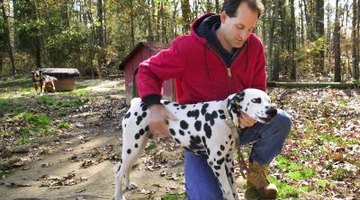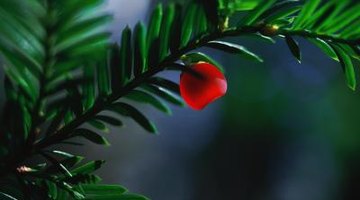Tips on Landscaping a Dog Kennel in the Back Yard
Creating a safe, comfortable, dog-friendly environment in your back yard requires that you understand both landscaping and canine behavior. Certain plants help keep your dog warmer in winter and cooler in summer. You can plant herbs that repel bothersome insects such as fleas, flies and ants. But choosing plants for landscaping around your dog’s kennel also can make the difference between life or death, because some plants are toxic to dogs.
Protection from Weather

Dogs with outdoor kennel areas need protection from adverse weather. Even when you put a doghouse in the kennel area, attention to plant placement can increase your dog’s comfort. Shade from trees and shrubs cools dogs in hot weather. Deciduous plants keep dogs warmer in winter by allowing sunlight to reach their kennel after plants drop their leaves in autumn. The U.S. Department of Energy advocates plant placement as a windbreak, and planting low-growing dense evergreen shrubs outside the north and northwest areas of your dog’s kennel buffers cold winter winds.
Toxic Plants

Many landscape plants are toxic, although that does not mean they are necessarily fatal. Common plant-poisoning symptoms for dogs include stomach discomfort and burning of the mouth. However, some plants can be deadly to dogs that eat them, and these plants can grow quickly into fenced kennel areas if you plant them too close to the kennel. All parts of azaleas and rhododendrons are poisonous and can cause dogs to lapse into comas. Cycads contain a toxin in the roots and stems that damages liver function, which can cause a dog to bleed to death, according to Dr. Murl Bailey at the Texas A&M College of Veterinary Medicine. Bailey also advises against planting oleander, another poisonous plant that can kill dogs.
Perimeter Path
Dogs instinctively guard perimeters around their territory. If your dog has access outside the kennel into your fenced yard, leave an unplanted path around the inside perimeter of the fence. This lets the dog patrol its area without damaging any plants in this path. Consider mulching this area with wood chips or pinestraw to cover sparse turf areas that your dog creates. Left unmulched, bare spots in your yard create mud puddles each time it rains.
Insect-Repellent Herbs
Insect pests not only annoy dogs, but they can also lead to skin infections from excessive scratching or carry parasites such as heartworms and tapeworms. Although mint does not kill insects, “Mother Earth News” reports that ants, flies and fleas avoid plantings of mint. Fennel also repels fleas, as evidenced by the gardeners' rhyme “Planting fennel at your dog’s kennel.” You need to plant fennel seeds where you want the plants to grow, because this herb resists transplanting.
References
Writer Bio
Victoria Lee Blackstone is a horticulturist and a professional writer who has authored research-based scientific/technical papers, horticultural articles, and magazine and newspaper articles. After studying botany and microbiology at Clemson University, Blackstone was hired as a University of Georgia Master Gardener Coordinator. She is also a former mortgage acquisition specialist for Freddie Mac in Atlanta, GA.
Photo Credits
- Thinkstock Images/Comstock/Getty Images
- Stockbyte/Stockbyte/Getty Images
More Articles



